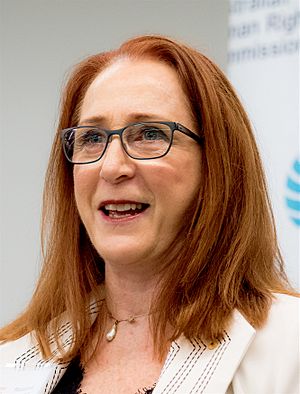Australian Human Rights Commission facts for kids
 |
|
| Commission overview | |
|---|---|
| Formed | 1986 |
| Preceding commission |
|
| Jurisdiction | Australia |
| Headquarters | Sydney |
| Employees | 126 |
| Minister responsible |
|
| Commission executives |
|
| Key documents |
|
The Australian Human Rights Commission is the national human rights institution of Australia, established in 1986 as the Human Rights and Equal Opportunity Commission (HREOC) and renamed in 2008. It is a statutory body funded by, but operating independently of, the Australian Government. It is responsible for investigating alleged infringements of Australia's anti-discrimination legislation in relation to federal agencies.
The Australian Human Rights Commission Act 1986 articulates the Australian Human Rights Commission's role and responsibilities. Matters that can be investigated by the Commission under the Australian Human Rights Commission Regulations 2019 include discrimination on the grounds of age, medical record, an irrelevant criminal record; disability; marital or relationship status; nationality; sexual orientation; or trade union activity.
Contents
Legislation
From its introduction until 2000, the Commission hosted the Commissioner administering the Privacy Act 1988 (Cth).
The Commission investigates alleged infringements under the following federal legislation:
- Racial Discrimination Act 1975 (Cth)
- Sex Discrimination Act 1984 (Cth)
- Disability Discrimination Act 1992 (Cth)
- Age Discrimination Act 2004 (Cth)
- Australian Human Rights Commission Act 1986 (Cth) (formerly Human Rights and Equal Opportunity Commission Act 1986)
The Australian Human Rights Commission Act 1986 articulates the Australian Human Rights Commission's role and responsibilities. It gives effect to Australia's obligations under the following:
- International Covenant on Civil and Political Rights (ICCPR);
- Convention Concerning Discrimination in Respect of Employment and Occupation (ILO 111);
- Convention on the Rights of Persons with Disabilities;
- Convention on the Rights of the Child;
- Declaration of the Rights of the Child;
- Declaration on the Rights of Disabled Persons;
- Declaration on the Rights of Mentally Retarded Persons; and
- Declaration on the Elimination of All Forms of Intolerance and of Discrimination Based on Religion or Belief.
Matters that can be investigated by the Commission under the Australian Human Rights Commission Regulations 2019 include discrimination on the grounds of age, medical record, an irrelevant criminal record; disability; marital or relationship status; nationality; sexual orientation; or trade union activity.
Public inquiries
One of the more visible functions of the commission is to conduct public inquiries. Some examples of inquiries conducted include:
- Homeless Children Inquiry (1989)
- National Inquiry into Racist Violence in Australia (1989-1991)
- Inquiry into the Accessibility of electronic commerce and new service and information technologies for older Australians and people with a disability (2000)
- Pregnancy Discrimination Inquiry (2000)
- Same-Sex: Same Entitlements Inquiry into financial and workplace discrimination against same-sex couples
- Separation of Aboriginal and Torres Strait Islander Children from their Families (Bringing Them Home Report (1997))
- National Inquiry into Children in Immigration Detention (2004) The report, A Last Resort? was published in April 2004.
- National Inquiry into Children in Immigration Detention (2014) The Forgotten Children report was submitted by Gillian Triggs in November 2014.
- Pregnancy and Return to Work National Review (2014)
Gender identity
Private members' bills introduced from both the Australian Greens and the Australian Democrats tried to add gender identity to the list of matters that can be investigated by the commission, which always failed to pass at least one house of parliament between 1995 and June 2007, because of a lack of support from both the Australian Labor Party and the Coalition in the federal parliament.
Relevant legislation was later passed in Acts such as the Sex Discrimination Amendment Act 2013.
Human Rights Awards and Medals
Since 1987, the Human Rights Awards have been presented at the commission's annual Human Rights Medal and Awards ceremony.
International status
The Commission is one of some 70 national human rights institutions (NHRIs) accredited by the Global Alliance of National Human Rights Institutions (GANHRI), a body sponsored by the Office of the United Nations High Commissioner for Human Rights (OHCHR). The Commission's full ("A status") accreditation has allowed it special access to the United Nations human rights system, including speaking rights at the Human Rights Council and other committees. The Commission has been able to present parallel reports ("shadow reports") to UN treaty committees examining Australia's compliance with international human rights instruments. It has been very active in developing NHRIs throughout the Asia-Pacific region, and is a leading member of the Asia Pacific Forum of NHRIs, one of four regional sub-groups of NHRIs.
In April 2022, GANHRI informed the Commission that it has lost its "A status" and that its status would be reviewed after approximately 18 months. GANHRI found that recent government decisions to appoint Commissioners had not been made with appropriate transparency. It was also concerned about accumulated reductions in funding.


